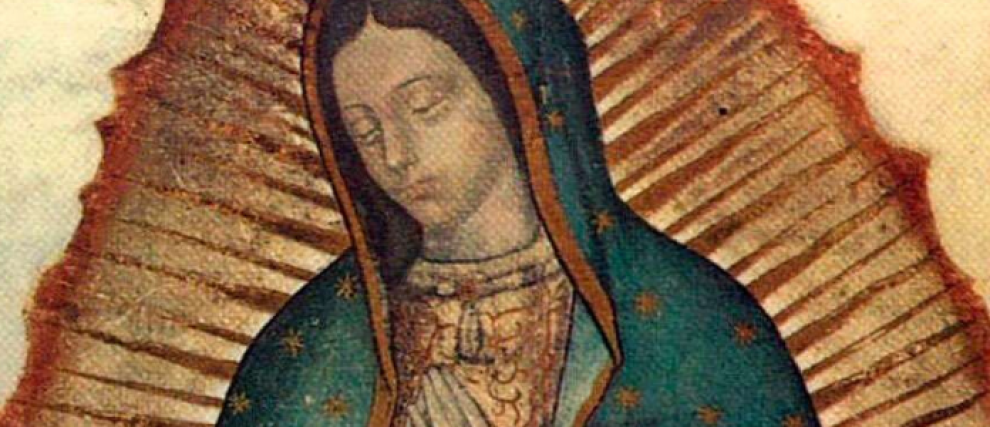Guadalupe: Apparitions, Miracles, Message, Sanctuary, Pilgrimage, Prayer
In December 1531, in a context of division between Spanish colonists and conflict with the indigenous Aztecs of Mexico, the Virgin Mary appeared in the form of a mestiza to a young Aztec peasant, recently baptized. She called for reconciliation between peoples and the construction of a sanctuary at the site of her apparition. Our Lady of Guadalupe would come to be known as “The Virgin who shaped a nation: Mexico.” Indeed, following the apparitions, many indigenous people converted, and the Spanish colonists were rekindled in their faith. She became the starting point for the evangelization of the entire South American continent, and miracles abound at Guadalupe, not least due to the many mysteriously inexplicable elements surrounding the Tilma, the cloak of Juan Diego on which the image of the Virgin is imprinted.
History of the Apparitions
Juan Diego, aged 57, was on his way to Mexico City on the morning of December 9, 1531, passing near the hill of Tepeyac. He had recently converted to Christianity and been baptized. As he walked by the hill, he heard melodious bird songs and a voice calling him from the top of the hill. He climbed the hill and, upon reaching the summit, was utterly amazed by what he saw. He described: “a lady with a long robe shining like the sun, the rocks and stones around her glowing like precious gems, and several rainbows filling the sky and the earth.” She introduced herself as the Virgin Mary, Mother of God, in Juan Diego's native language, and asked him to go to the bishop to request the construction of a church on the hill. Juan Diego immediately went to the bishop's residence. After a long wait, he was politely received, but the bishop showed little interest.
Diego returned to the Virgin, sharing his disappointment and asking her to choose someone else, as he was too poor to be taken seriously by the bishop. The Virgin gently insisted and asked him to return to the bishop, persisting in his request. During his second visit, the bishop asked him to bring back a sign to prove the apparition he claimed to have witnessed. After several days without being able to visit the hill, Juan Diego went to the top at the Virgin's urging, and he was astonished to find the ground, which had been frozen, covered with magnificent flowers. He eagerly gathered the flowers and placed them in his tilma, a type of cloak worn by indigenous people at the time. He went to the bishop's residence, and when he opened his tilma, both he and the bishop were amazed by the image imprinted on it, depicting the Virgin. They fell to their knees. The bishop then placed the tilma in his private chapel and ordered the construction of a chapel in the following days. He visited the site of the apparitions.
Message of Our Lady of Guadalupe
In a violent context of massacres of the indigenous people and fierce power struggles among the Spanish, the Virgin brought a powerful message of peace and hope. She told Juan Diego that her maternal love was for “all the people of this land, whatever their lineage, all those who love and pray to me.”
She also said: “Listen to what I am about to tell you, and let it sink into your heart: Do not let anything depress or discourage you... Am I not here, I who am your Mother? Are you not under my shadow and protection? Am I not your fountain of life? Are you not cradled in the folds of my mantle? In my arms? Is there anything else you need?”
The Virgin thus extended a hand of love to the oppressed Aztec people.
Miracles of Our Lady of Guadalupe
The Image
The image itself is a miracle and has been analyzed for centuries. Even with the latest imaging and textile analysis techniques, it remains an eternal mystery. First, its composition and the symbols it contains are such that it can only be fully understood by someone of Aztec culture: her posture resembles a prayerful dance, as the indigenous people loved to pray. On her abdomen, a four-petaled flower, a sacred symbol representing the supreme God. She wears her hair loose, a symbol of virginity among the Aztecs. Moreover, her hands are in prayer, and one appears darker than the other, symbolizing the mixing of the two peoples. The Virgin herself appears mestiza.
In her eyes, it was only recently discovered, thanks to advanced technology, that one can see the reflections of Juan Diego and the bishop. The 46 stars on her mantle are said to represent the stars of the winter solstice on December 12, 1531, as confirmed by astronomers. In the 20th century, it was discovered that there are no pigments in this image, nor is it a print. Finally, the fabric itself, made of plant fibers, remains completely incorrupt for 450 years, which is utterly impossible! A copy made with the same fabric did not survive 15 years!
Miracles Surrounding the Apparitions
Juan Diego's uncle was healed while Juan Diego was on his way to fetch a priest and was diverted by the Virgin. She even appeared to the uncle, revealing her name as “Ever Virgin of Guadalupe.”
A few weeks later, during a procession carrying the Tilma to Mount Tepeyac, an arrow accidentally struck an indigenous man carrying the garment, and he died. The arrow was removed in front of the image, and the man immediately came back to life.
All this without mentioning the explosion of conversions following the apparitions. Some claim that “the miraculous image of Our Lady of Guadalupe did more for the conversion of the Indians than all previous preaching.”
Even lukewarm Spaniards turned back to Mary and Christ after the apparitions of the Virgin of Guadalupe.
Miracles in the Following Centuries
In the 16th century, an Italian admiral owned a painted copy of Our Lady of Guadalupe. Before the Battle of Lepanto, he prayed before it and was spared.
Also in the 16th century, the image was taken to Mexico City to ask for the Virgin's protection against floods. It proved highly effective.
In the 18th century, acid accidentally spilled on the Tilma, leaving a 10 cm hole. A month later, the fabric had repaired itself without any human intervention.
At the beginning of the 20th century, an anarchist placed a bomb at the feet of the Tilma. The explosion destroyed everything around it, except the Tilma and the glass protecting it.
Discoveries have accelerated in recent decades with improved technology. It was found that the Tilma seems to maintain a constant temperature of 37 °C.
Pilgrimages to Our Lady of Guadalupe
After the first chapel built following the apparitions, a church was constructed at the end of the 16th century. New, ever-larger churches were continually built to accommodate the growing number of pilgrims each year. Today, 20 million people come to pray before the Virgin of Guadalupe annually. The basilica is the second most visited Catholic pilgrimage site in the world, after the Vatican and St. Peter's in Rome.
After being named patroness of Mexico City, then patroness of Mexico, then patroness of Latin America, and later patroness of the Philippines, she is now proclaimed “Queen of Mexico” (1895) and “Empress of the Americas” (2000).
The Virgin of Guadalupe is also prayed to for unborn children, as her belt indicates her pregnancy.
Prayers to Our Lady of Guadalupe
Prayer of Devotion to Our Lady of Guadalupe
“Our Lady of Guadalupe, I know with certainty that You are the perfect and perpetual Virgin Mary, Mother of the true God. You show and offer me Your love, Your compassion, Your help, Your protection. You are the merciful Mother, Mother of all who love You, who implore You, who trust in You. You hear my cries and my sorrows. You heal and ease my sufferings, my needs, my misfortunes. You ask me not to be troubled or crushed by my grief and not to fear illness, vexations, anxieties, or pains. You are my Mother, and I am under Your protection. You are my Fountain of life, and I am cradled in Your arms! Mother of mercy, with love, I consecrate my entire being, my life, my sufferings, my joys, all those You have entrusted to me, and all that belongs to me. I desire to be entirely Yours and to walk with You on the path of holiness. O Immaculate Virgin, hear the prayer I address to You with filial trust, and present it to Your divine Son. Our Lady of Guadalupe, Patroness of the unborn, grant us the grace to love, give, welcome, and respect life, with the same love with which You conceived in Your womb the life of Jesus, Your beloved Son. Holy Mary, Queen of families, protect and help our families, so that they may always remain united; assist us in the education of our children and bless them. I beg You, most holy Mother, give me a great love for the Eucharist and regular Confession, a taste for prayer and meditation, so that I may bring peace and joy through Jesus Christ our Lord, who with God the Father and the Holy Spirit, lives and reigns forever and ever. Amen.”
Find more beautiful prayers to the Virgin of Guadalupe.
Pray to the Virgin on Hozana with...
The Virgin asked, during her apparition to Juan Diego, that all Christians open their hearts to her. Ask for the intercession of for nine days to entrust her with your deepest desires.
She is called the “Virgin of the Impossible” because no request is refused by the Lord when brought to Him by the Virgin Mary. Entrust your intentions to the Virgin with .

